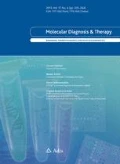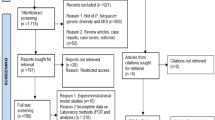Abstract
Malaria is a leading cause of morbidity and mortality worldwide. Prompt diagnosis and treatment are critical factors in reducing morbidity and mortality, as delayed treatment of malaria increases the risk of death. Microscopy has long been the standard of malaria diagnosis, but newer diagnostic tests now offer advantages in certain settings. Malaria diagnosis is complicated by the fact that acquired immunity to malaria can result in asymptomatic infections. In a symptomatic (febrile) patient, no existing malaria diagnostic test can distinguish malarial illness from parasitemia with concomitant fever of another cause. In this review we discuss the available malaria diagnostic tests, appropriate applications for each, and the challenges of malaria diagnosis in both endemic and non-endemic settings.
Similar content being viewed by others
References
Breman JG. The ears of the hippopotamus: manifestations, determinants, and estimates of the malaria burden. Am J Trop Med Hyg 2001; 64(1-2 Suppl.): 1–11
Snow RW, Craig M, Deichmann U, et al. Estimating mortality, morbidity and disability due to malaria among Africa’s non-pregnant population. Bull World Health Organ 1999; 77(8): 624–40
Cox-Singh J, Davies TM, Lee KS, et al. Plasmodium knowlesi malaria in humans is widely distributed and potentially life threatening. Clin Infect Dis 2008; 46(2): 165–71
Singh B, Kim Sung L, Matusop A, et al. A large focus of naturally acquired Plasmodium knowlesi infections in human beings. Lancet 2004; 363(9414): 1017–24
Luchavez J, Espino F, Curameng P, et al. Human infections with Plasmodium knowlesi, the Philippines. Emerg Infect Dis 2008; 14(5): 811–3
Ng OT, Ooi EE, Lee CC, et al. Naturally acquired human Plasmodium knowlesi infection, Singapore. Emerg Infect Dis 2008; 14(5): 814–6
Zheng H, Zhu HM, Ning BF, et al. Molecular identification of naturally acquired Plasmodium knowlesi infection in a human case [in Chinese]. Zhongguo Ji Sheng Chong Xue Yu Ji Sheng Chong Bing Za Zhi 2006; 24(4): 273–6
White NJ, Ho M. The pathophysiology of malaria. Adv Parasitol 1992; 31: 83–173
Kailander K, Nsungwa-Sabiiti J, Peterson S. Symptom overlap for malaria and pneumonia: policy implications for home management strategies. Acta Trop 2004; 90(2): 211–4
O’Dempsey TJ, McArdle TF, Laurence BE, et al. Overlap in the clinical features of pneumonia and malaria in African children. Trans R Soc Trop Med Hyg 1993; 87(6): 662–5
Reyburn H, Mbatia R, Drakeley C, et al. Overdiagnosis of malaria in patients with severe febrile illness in Tanzania: a prospective study. BMJ 2004; 329(7476): 1212
Chandramohan D, Jaffar S, Greenwood B. Use of clinical algorithms for diagnosing malaria. Trop Med Int Health 2002; 7(1): 45–52
Eliades MJ, Shah S, Nguyen-Dinh P, et al. Malaria surveillance: United States, 2003. MMWR Surveill Summ 2005; 54(2): 25–40
Skarbinski J, James EM, Causer LM, et al. Malaria surveillance: United States, 2004. MMWR Surveill Summ 2006; 55(4): 23–37
Thwing J, Skarbinski J, Newman RD, et al. Malaria surveillance: United States, 2005. MMWR Surveill Summ 2007; 56(6): 23–40
Warrell DA, Gilles HM, editor. Essential malariology. 4th ed. London: Arnold, 2002
Barat L, Chipipa J, Kolczak M, et al. Does the availability of blood slide microscopy for malaria at health centers improve the management of persons with fever in Zambia? Am J Trop Med Hyg 1999; 60(6): 1024–30
Kain KC, Harrington MA, Tennyson S, et al. Imported malaria: prospective analysis of problems in diagnosis and management. Clin Infect Dis 1998; 27(1): 142–9
Dorsey G, Gandhi M, Oyugi JH, et al. Difficulties in the prevention, diagnosis, and treatment of imported malaria. Arch Intern Med 2000; 160(16): 2505–10
Proux S, Hkirijareon L, Ngamngonkiri C, et al. Paracheck-Pf: a new, inexpensive and reliable rapid test for P. falciparum malaria. Trop Med Int Health 2001; 6(2): 99–101
Moody A. Rapid diagnostic tests for malaria parasites. Clin Microbiol Rev 2002; 15(1): 66–78
Murray CK, Bell D, Gasser RA, et al. Rapid diagnostic testing for malaria. Trop Med Int Health 2003; 8(10): 876–83
Mboera LE, Fanello CI, Malima RC, et al. Comparison of the Paracheck-Pf test with microscopy, for the confirmation of Plasmodium falciparum malaria in Tanzania. Ann Trop Med Parasitol 2006; 100(2): 115–22
Mason DP, Kawamoto F, Lin K, et al. A comparison of two rapid field immunochromatographic tests to expert microscopy in the diagnosis of malaria. Acta Trop 2002; 82(1): 51–9
Rubio JM, Buhigas I, Subirats M, et al. Limited level of accuracy provided by available rapid diagnosis tests for malaria enhances the need for PCR-based reference laboratories. J Clin Microbiol 2001; 39(7): 2736–7
Iqbal J, Khalid N, Hira PR. Comparison of two commercial assays with expert microscopy for confirmation of symptomatically diagnosed malaria. J Clin Microbiol 2002; 40(12): 4675–8
Happi CT, Gbotosho GO, Sowunmi A, et al. Malaria diagnosis: false negative parasight-F tests in falciparum malaria patients in Nigeria. Afr J Med Med Sci 2004; 33(1): 15–8
Huong NM, Davis TM, Hewitt S, et al. Comparison of three antigen detection methods for diagnosis and therapeutic monitoring of malaria: a field study from southern Vietnam. Trop Med Int Health 2002; 7(4): 304–8
Baker J, McCarthy J, Gatton M, et al. Genetic diversity of Plasmodium falciparum histidine-rich protein 2 (PfHRP2) and its effect on the performance of PfHRP2-based rapid diagnostic tests. J Infect Dis 2005; 192(5): 870–7
Bartoloni A, Strohmeyer M, Sabatinelli G, et al. False positive ParaSight-F test for malaria in patients with rheumatoid factor. Trans R Soc Trop Med Hyg 1998; 92(1): 33–4
Moody AH, Chiodini PL. Non-microscopic method for malaria diagnosis using OptiMAL IT, a second-generation dipstick for malaria pLDH antigen detection. Br J Biomed Sci 2002; 59(4): 228–31
Bell D, Wongsrichanalai C, Barnwell JW. Ensuring quality and access for malaria diagnosis: how can it be achieved? Nat Rev Microbiol 2006; 4(9 Suppl.): S7–20
Inverness Medical Professional Diagnostics. BinaxNOW® malaria test kit [product instructions; online]. Available from URL: http://www.binax.com/uploads/binaxnowmalaria-productinsert6_2007.pdf [Accessed 2008 Aug 6]
Center for Devices and Radiological Health, US Food and Drug Administration. Decision summary and labeling [online]. Available from URL: http://www.fda.gov/cdrh/pdf6/k061542.pdf [Accessed 2008 Aug 6]
Stauffer W, Fischer PR. Diagnosis and treatment of malaria in children. Clin Infect Dis 2003; 37(10): 1340–8
Zucker JR, Campbell CC. Malaria: principles of prevention and treatment. Infect Dis Clin North Am 1993; 7(3): 547–67
Center for Disease Control and Prevention. Treatment of malaria (guidelines for clinicians) [online]. Available from URL: http://www.cdc.gov/malaria/diagnosis_treatment/tx_clinicians.htm [Accessed 2008 Aug 6]
Center for Disease Control. Notice to readers: malaria rapid diagnostic test. MMWR Morb Mortal Wkly Rpt 2007; 56 (27): 686 [online]. Available from URL: http://www.cdc.gov/mmwr/preview/mmwrhtml/mm5627a4.htm [Accessed 2008 Aug 6]
Metselaar D, van Thiel PM. Classification of malaria. Trop Geograph Med 1959; 11: 157–61
Beier JC, Killeen GF, Githure JI. Short report: entomologic inoculation rates and Plasmodium falciparum malaria prevalence in Africa. Am J Trop Med Hyg 1999; 61(1): 109–13
World Health Organization, Department of Child and Adolescent Health and Development. Integrated management of childhood illness for high HIV settings [online]. Available from URL: http://whqlibdoc.who.int/publications/2006/9789241594370.cb_eng.pdf [Accessed 2008 Aug 27]
Rougemont A, Breslow N, Brenner E, et al. Epidemiological basis for clinical diagnosis of childhood malaria in endemic zone in West Africa. Lancet 1991; 338(8778): 1292–5
Njama-Meya D, Kamya MR, Dorsey G. Asymptomatic parasitaemia as a risk factor for symptomatic malaria in a cohort of Ugandan children. Trop Med Int Health 2004; 9(8): 862–8
Grobusch MP, Egan A, Gosling RD, et al. Intermittent preventive therapy for malaria: progress and future directions. Curr Opin Infect Dis 2007; 20(6): 613–20
Zurovac D, Njogu J, Akhwale W, et al. Effects of revised diagnostic recommendations on malaria treatment practices across age groups in Kenya. Trop Med Int Health 2008; 13(6): 784–7
Hamer DH, Ndhlovu M, Zurovac D, et al. Improved diagnostic testing and malaria treatment practices in Zambia. JAMA 2007; 297(20): 2227–31
Lubell Y, Reyburn H, Mbakilwa H, et al. The impact of response to the results of diagnostic tests for malaria: cost-benefit analysis. BMJ 2008; 336(7637): 202–5
Wasunna B, Zurovac D, Goodman CA, et al. Why don’t health workers prescribe ACT? A qualitative study of factors affecting the prescription of artemether-lumefantrine. Malar J 2008; 7: 29
Zurovac D, Njogu J, Akhwale W, et al. Translation of artemether-lumefantrine treatment policy into paediatric clinical practice: an early experience from Kenya. Trop Med Int Health 2008; 13(1): 99–107
Zurovac D, Ndhlovu M, Sipilanyambe N, et al. Paediatric malaria case-management with artemether-lumefantrine in Zambia: a repeat cross-sectional study. Malar J 2007; 6: 31
Wiseman V, Kim M, Mutabingwa TK, et al. Cost-effectiveness study of three antimalarial drug combinations in Tanzania. PLoS Med 2006; 3(10): e373
Lubell Y, Reyburn H, Mbakilwa H, et al. The cost-effectiveness of parasitologic diagnosis for malaria-suspected patients in an era of combination therapy. Am J Trop Med Hyg 2007; 77(6 Suppl.): 128–32
Shillcutt S, Morel C, Goodman C, et al. Cost-effectiveness of malaria diagnostic methods in sub-Saharan Africa in an era of combination therapy. Bull World Health Organ 2008; 86(2): 101–10
Njama-Meya D, Clark TD, Nzarubara B, et al. Treatment of malaria restricted to laboratory-confirmed cases: a prospective cohort study in Ugandan children. Malar J 2007 Jan 21; 6: 7
Author information
Authors and Affiliations
Corresponding author
Rights and permissions
About this article
Cite this article
Bronzan, R.N., McMorrow, M.L. & Patrick Kachur, S. Diagnosis of Malaria. Mol Diag Ther 12, 299–306 (2008). https://doi.org/10.1007/BF03256295
Published:
Issue Date:
DOI: https://doi.org/10.1007/BF03256295




